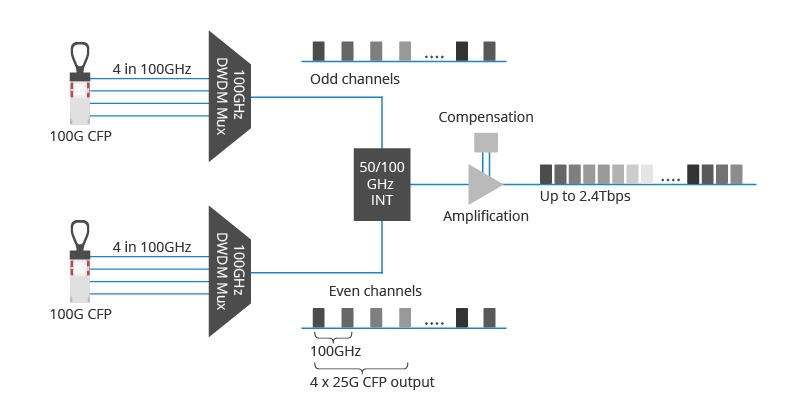Key Technologies for 100G Metro Network Upgrades
As network technologies rapidly advance, we're seeing a surge in new applications driving the demand for improved bandwidth. This trend is pushing network upgrades towards the high-speed realm of 100G Ethernet. The same holds true for metropolitan area networks, where the need for more channels at higher data rates is increasingly crucial. Transitioning to 100G metropolitan networks comes with its challenges, yet cutting-edge technologies are ready to support these networks, ensuring they meet the demands of our ever-connected and data-hungry world.
Challenges for 100G Metro Network
Affected by factors such as long-distance links and high-density transmission, 100G transmission over metropolitan area networks is very challenging. Below are the challenges facing 100G metropolitan area networks.
Link Loss: 100G metro networks contain a large number of ROADMs, which leads to an increase in loss. Besides, the signal loss may increase due to older metro fiber and numerous connectivity points.
Cost & Density: Since metro networks are usually large in scale, they are more cost-sensitive and require high port density.
Latency: Low latency is crucial for high-speed network upgrades, especially in metro-centric use cases such as financial applications. Ensuring low latency is essential for maintaining the desired quality of 100G transmission in metro networks.
Technology Used in 100G Metro Network
To meet the high-capacity and long-distance transmission requirements of 100G metro networks, advanced DWDM technology and coherent optics are being adopted. Besides, a new signal transmission technology, PAM4, has been developed to provide a new solution for 100G Ethernet connectivity in metropolitan area networks.
DWDM Technology
DWDM is a fiber-optic transmission technique that multiplexes many different wavelength signals onto a single fiber, while maintaining complete separation of the data streams. DWDM can greatly increase the bandwidth and extend the transmission distance of optical networks. Metro deployment of the 100G network requires DWDM components, including DWDM Mux/Demux, optical amplifiers, and dispersion compensators.
-
DWDM Mux/Demux
The DWDM multiplexer or de-multiplexer is a core optical multiplex technology that puts data from various sources on an optical fiber, each signal traveling at the same speed on its own light wavelength. DWDM Mux/Demux can extend the bandwidth of optical communication networks with low cost and long transmission distance, making it ideal for 100G metro networks.
-
Optical Amplifiers
Optical amplifiers can overcome the additional losses caused by fiber attenuation, optical power splitting, and other factors, extending the fiber links for long-haul signal transport. For DWDM applications, EDFA is the optimal choice as it provides high small signal gains and output powers.
-
Dispersion Compensation Modules
The Dispersion Compensation Modules (DCM) provides chromatic dispersion compensation for long-span transmission fibers, supporting ultra-long 100G fiber transport of metro networks.
-
DWDM CFP-DCO Coherent Modules
A 100G metropolitan network is primarily built upon the utilization of the 100G DWDM CFP coherent optical module. This module comes equipped with four independent channels, allowing for adjustable wavelength allocation within the DWDM network. What sets this module apart is its adoption of single-mode duplex fiber transmission technology, providing an efficient and stable 100G transmission solution with a total rate of 4*25G. As a result, this network architecture not only excels in performance but also meets the high-speed, tunable wavelengths, and reliability requirements of metropolitan networks.

Coherent Optical Technology
For 100G metro networks, coherent optics, especially small pluggable CFP2 and CFP4 modules, have gained widespread attention and adoption because of their optimized performance and size. The basis of coherent optics lies in technologies such as higher-order modulation and coherent detection. In addition, DSP and FEC are also of great significance for enhancing the transmission capability of 100G coherent optical communication systems.
-
Digital Signal Processors
Electronically compensate for Chromatic and Polarization Mode Dispersion to enable robust performance and eliminate the need for DCM, making coherent systems commercially viable.
-
Forward Error Correction (FEC)
Forward Error Correctionis a method of reducing data transmission errors, effectively enhancing OSNR and extending the transmission range of high-speed optical systems.
PAM4 Modulation
Pulse amplitude modulation (PAM4) emerges as a sophisticated modulation technique tailored for short-distance fiber connections. Leveraging four amplitude pulses, with each carrying two bits, PAM4 effectively doubles the bandwidth compared to traditional binary approaches. The straightforward design and minimal power demands of PAM4 position it as a sought-after choice, particularly in the realm of 100G and 400G Ethernet applications.
-
QSFP28 Transceiver Modules
The 100G PAM4 QSFP28, utilizing PAM4 modulation, supports 100 Gigabit transmission speeds and is suitable for many short-range applications.
-
PAM4 Deployment
PAM4 technology can be deployed with existing DWDM systems, although additional inline multiplexing and dispersion compensation are required for links of over six kilometers.

Conclusion
The cutting-edge technologies discussed earlier pave the way for outstanding ethernet performance, facilitating the seamless transmission of 100G over extended distances in metropolitan area networks. Diverse 100G metro network solutions have emerged, leveraging different technologies. However, there are still challenges, such as cost and cabling limitations. Ongoing technological advancements are crucial to overcome these hurdles and ensure the continued evolution of cost-efficient 100G metro networks.
You might be interested in
Email Address

-
PoE vs PoE+ vs PoE++ Switch: How to Choose?
Mar 16, 2023
















